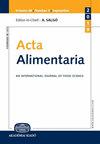高梁种子提取物绿色合成纳米银、表征及生物活性研究
IF 1
4区 农林科学
Q4 FOOD SCIENCE & TECHNOLOGY
引用次数: 0
摘要
利用物理和化学方法合成纳米粒子是一个漫长而昂贵的过程。众所周知,生物合成纳米粒子比其他方法更便宜、更容易。在本研究中,利用高粱(Körn) Stapf ex Holland种子提取物,俗称高粱,通过生物合成获得了纳米银(AgNP),也称为绿色合成。用SEM、EDS、TEM、FT-IR和UV-Vis光谱对AgNPs进行了表征。SEM图像证实AgNPs的形状为球形。TEM分析表明,AgNPs的平均尺寸在51 ~ 56 nm之间。能谱分析通过检测到3 KeV的银离子峰证实了AgNPs的存在。紫外可见光谱分析表明,AgNPs在450 nm处的吸光度最大,呈棕紫红色。通过抗菌、抗生物膜、抗氧化、诱变和DNA裂解活性分析,对提取物和AgNPs的生物活性进行了研究。该提取物对革兰氏阳性杆菌枯草芽孢杆菌的MIC值最高(0.62 μ mL−1),而AgNPs对革兰氏阴性杆菌大肠杆菌的MIC值最高(0.31 μ mL−1)。结果表明,AgNPs对枯草芽孢杆菌的生物膜抑制率最高,对白色念珠菌和铜绿假单胞菌的生物膜抑制率最高。采用DPPH•和ABTS•+方法对其抗氧化活性进行评价,结果表明,两种样品均具有较高的抗氧化活性。采用2株鼠伤寒沙门菌(TA98和TA100)进行Ames/ Salmonella试验,评价提取物和AgNPs的致突变性。提取物对两种菌株的诱变活性随浓度的增加而增加,而AgNP在任何浓度下都没有表现出诱变活性。琼脂糖凝胶电泳方法表明,提取物和AgNPs在氧化剂的存在下可切割DNA。本文章由计算机程序翻译,如有差异,请以英文原文为准。
Green synthesis of silver nanoparticles using Sorghum bicolor var. technicum seed extract, their characterisation and investigation of biological activities
Abstract Synthesis of nanoparticles can be long and costly processes using physical and chemical methods. Biological synthesis of nanoparticles is known to be cheaper and easier than other methods. In this study, silver nanoparticles (AgNP) were obtained by biological synthesis, also known as green synthesis, using Sorghum bicolor var. technicum (Körn) Stapf ex Holland seed extract, popularly known as sorghum. AgNPs were characterised by SEM, EDS, TEM, FT-IR, and UV-Vis Spectroscopy. SEM images confirmed that the shape of AgNPs was spherical. TEM analysis showed that the average sizes of AgNPs ranged from 51 to 56 nm. EDS analysis confirmed the presence of AgNPs by detecting a silver ion peak at 3 KeV. UV-Vis spectroscopy analyses indicated that the brown-burgundy colour of AgNPs exhibited maximum absorbance at 450 nm. The biological activities of the extract and AgNPs were investigated through antimicrobial, antibiofilm, antioxidant, mutagenic, and DNA cleavage activity analyses. The extract exhibited the highest MIC value against Gram-positive bacterium Bacillus subtilis (0.62 μg mL −1 ), whereas AgNPs demonstrated the highest antimicrobial activity specifically against Gram-negative bacterium Escherichia coli (0.31 μg mL −1 ). The antibiofilm results revealed that the extract displayed the highest percentage of biofilm inhibition against B. subtilis , while AgNPs exhibited notable efficacy against both Candida albicans yeast and Pseudomonas aeruginosa bacterium. The antioxidant activities were evaluated using DPPH • and ABTS •+ methods, and it was determined that both samples had high antioxidant activity. Mutagenicity of the extract and AgNPs were evaluated by the Ames/ Salmonella test using two strains of Salmonella typhimurium (TA98 and TA100). The mutagenic activity of the extract increased depending on the concentration for both strains, while AgNP did not show mutagenicity at any concentration. The agarose gel electrophoresis method showed that the extract and AgNPs cleaved DNA in the presence of an oxidising agent.
求助全文
通过发布文献求助,成功后即可免费获取论文全文。
去求助
来源期刊

Acta Alimentaria
农林科学-食品科技
CiteScore
1.80
自引率
0.00%
发文量
47
审稿时长
18-36 weeks
期刊介绍:
Acta Alimentaria publishes original papers and reviews on food science (physics, physical chemistry, chemistry, analysis, biology, microbiology, enzymology, engineering, instrumentation, automation and economics of foods, food production and food technology, food quality, post-harvest treatments, food safety and nutrition).
 求助内容:
求助内容: 应助结果提醒方式:
应助结果提醒方式:


